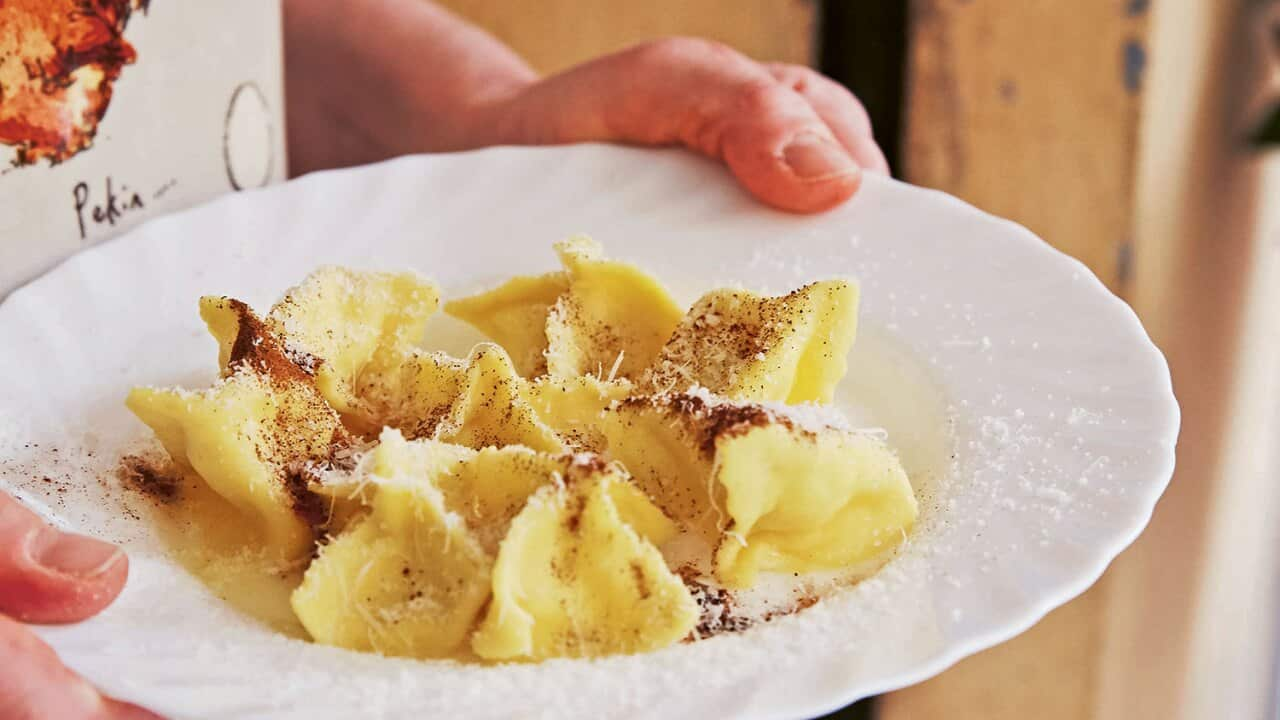makes
32
prep
55 minutes
cook
40 minutes
difficulty
Mid
makes
32
serves
preparation
55
minutes
cooking
40
minutes
difficulty
Mid
level
This recipe is by home cook Monica for the book, Pasta Grannies, edited by Vicky Bennison.
Ingredients
Pasta
- 300 g (10½ oz/scant 2½ cups) 00 flour or plain (all-purpose) flour
- 3 eggs
Filling
- 250 g (9 oz) ricotta (drained weight)
- 70 g (21/2 oz) grated parmigiano reggiano
- 1 unwaxed large lemon, zested
To serve
- 30 g (1 oz) butter
- 2 tsp ground cinnamon
Resting time: 30 minutes
Instructions
1. To make the pasta, tip the flour onto your board in a heap. Use your fingers to make a well in the centre and pour the eggs into the well. Take a fork (or use your fingers) and scramble the eggs together thoroughly. Incorporate the flour by scraping your fork round the inside of the flour wall, so a small quantity of flour falls into the egg mixture. Whisk in the flour, smooshing any lumps, so you gradually create a batter. Repeat until you have used all the flour and create a dough. If it is sticky, add a tablespoon of flour and knead it in. The dough should feel soft and pillowy, but not too sticky.
Alternatively, instead of using a fork and a board, you can beat the egg and flour together in a bowl, or with a food mixer.
2. Knead the dough for 10 minutes minimum (kneading develops the gluten and elasticity of the dough), working briskly to avoid the dough drying out. If the pasta feels too dry, damp your hands with water to put moisture back into the dough. You can also use a dough hook on your food mixer to knead. Your dough should feel silky and smooth - when you press your thumb into the dough, it should bounce back.
3. Place the dough in a bowl covered with a lid or cling film and cover it to stop it from drying out. Leave the dough at room temperature for 30 minutes, which relaxes the gluten and makes it easier to roll out.
4. Roll out the dough to about 1 mm thick, so you can see the board beneath it. Cut into 7 cm (2¾ inch) squares. If you have a special roller you can use this, but otherwise, you can use a ruler and a pastry cutter.
5. For the filling, combine all the ingredients. Dot a teaspoon of the ricotta mixture into the centre of each square. Gather the 4 points together and firmly press the adjoining edges together to create 4 seams. Repeat until you have used all your filling.
6. Bring a large pan of salted water to a gentle canter of a simmer and lower the cestini into it with a small sieve or slotted spoon. Cook for 3-4 minutes.
7. While the cestini are cooking, melt the butter in a small pan. When the cestini are ready, don't drain them, but scoop them out with a sieve or slotted spoon and plate them up with a couple of spoonfuls of melted butter and a dusting of cinnamon.
Cook's Notes
Oven temperatures are for conventional; if using fan-forced (convection), reduce the temperature by 20˚C. | We use Australian tablespoons and cups: 1 teaspoon equals 5 ml; 1 tablespoon equals 20 ml; 1 cup equals 250 ml. | All herbs are fresh (unless specified) and cups are lightly packed. | All vegetables are medium size and peeled, unless specified. | All eggs are 55-60 g, unless specified.
This recipe is by home cook Monica for the book, Pasta Grannies, edited by Vicky Bennison.









